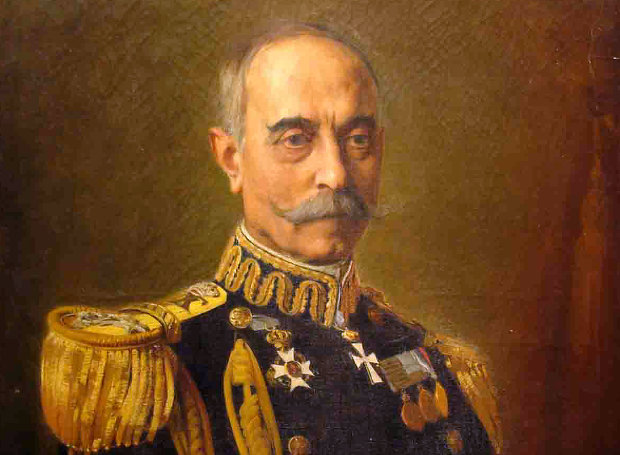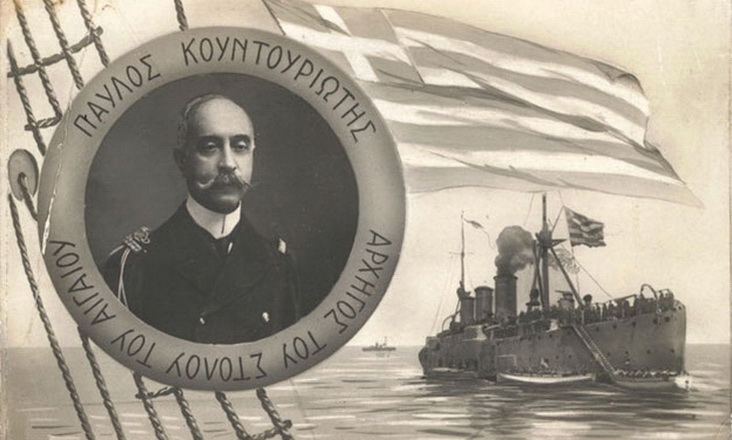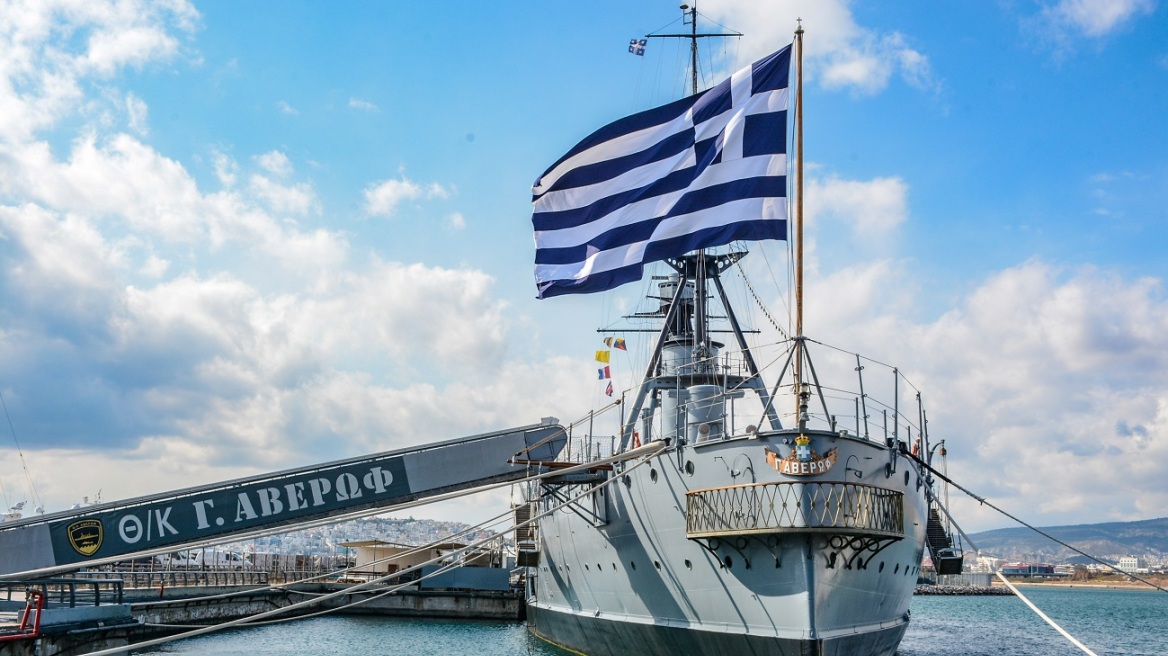Jan. 5 1913: The battle of Lemnos frees all Greek islands in Aegean
- Written by E.Tsiliopoulos
On January 5, 1913, and while the First Balkan War between the Ottoman Empire and the allied coalition of Greece, Bulgaria, Serbia and Montenegro was taking place, one of the most critical battles of modern Greek history took place.
It was a naval battle and went down in history as the Naval Battle of Lemnos. Its main protagonists were the Commander of the Aegean Fleet, Pavlos Kountouriotis and the legendary battleship "Averof".
As "Elefthero Vima" of January 6, 1933 states:
"The naval battle of Lemnos was the greatest naval event recorded in the Aegean after the incomparable victories of the revolution.
"And it firmly consolidated the maritime sovereignty of Greece, and contributed most significantly, through the absolute obstruction of the enemy's military transports, to the victorious outcome of the entire Balkan war".
"It is reasonable, therefore, that the memory of the nation always turns with such honor and gratitude to the glorious sailors, the first of whom, Pavlos Kountouriotis, remains the most loved and respected Greek of his generation".
Lemnos as a starting point
With the start of the First Balkan War, in October 1912, Kountouriotis implemented his plan to "squeeze" the Ottoman fleet in the Dardanelles.
Ας “Elefthero Vima” of August 23, 1935, writes:
"It is the morning of October 5, 1912. The Aegean fleet is concentrated in Faliron. A few hours ago, the news of the declaration of war sent shivers of excitement through the crews and crews.
"The flags of the ships wave nervously, impatiently in the Attic sky. On "Averof" the official ceremony of the promotion of the fleet takes place. Captain Kountouriotis is promoted to rear admiral.
"The admiral hastens to occupy Lemnos, in order to establish there the advanced base of the fleet"
The occupation of the Turkish-occupied Lemnos was carried out in a flash by the Greek navy, which thus "acquired from the first days a brilliant base, from which to monitor the enemy and ensuring a swift encounter with him, in the event of his exiting the straits, was ensured.
The Turkish attempt at distraction and the "mutiny" of Kountouriotis
In January 1913, the Turks attempted to "lure" the spearhead of the Greek navy, the battlecruiser Averof, away from Lemnos in order to recapture the island as well as the wider region of the Northeast Aegean.
"In the darkness of the winter night, the enemy cruiser "Hamidie" managed to escape the surveillance of the patrols through the straits in order to head to Syros and create the well-known distraction there."
The Greek government "fell" into the Turkish trap, but fortunately for Greece, not Kountouriotis.

The genius admiral refused to carry out the order of the Ministry of the Navy, which asked him to proceed in pursuit of Hamidie and did not leave the area of Lemnos with the "Averof", as the three older battleships that would have remained there would have been easy prey for the Turks.
The naval battle of Lemnos
At dawn on January 5, the Turks, certain that the trap had worked, sailed their ships out of the Dardanelles straits and headed for Lemnos, considering its recapture an easy task.
"It was the 5th of January 1913.Admiral Kountouriotis let the enemy get close enough to Lemnos and only then orders his fleet to withdraw from Moudros.
"He wants to remove the enemy from his base as much as possible, so that he had enough time and space to fight him"
"Averof" sailrd from the port of Moudros and Kountouriotis sent the following signal to his ships:
"The Admiral wishes a good day to the brave officers and crews. You are like lions."
The chase
Approaching Lemnos, the Turks were surprised to realize that the battleship "Averof", one of the most powerful naval weapons in the world at the time, was there and waiting for them fully armed. The Turkish fleet immediately changed course to the south.
"But it was fired upon fiercely and with great success by the Greek fleet, he is shaken, shaken and flees, he flees again subdued and at full speed towards the straits, towards his base"
Kountouriotis did what he loved most. With "Averof" he pursued, the enemy until the end.
"He separated from the old battleships and rushed in a frantic pursuit of the fleeing enemy (...). He struck in frenzy, fired at him and with all his anger and speed and bravery pursued him to the straits, where the opponent manages to sail with serious damage so that he would never leave there again.
"Kountouriotis foiled the enemy's attempt again. He forced his crushed opponent to return inactive to his base, and the state of the sea remained indisputably to the Greek fleet. The victorious paeans once again shook the Aegean.
"Nevertheless, the Admiral's complaint was and remained bitter that the circumstances did not allow him to sink the enemy".

The result
The victorious Naval Battles of Elli (December 3, 1912) and Lemnos (January 5, 1913) were the battles that, almost a century after the Greek Revolution of 1821, liberated the islands and waters of the northeastern Aegean.
"Thassos, Chios, Lemnos, Samos, Mytilini surrendered to freedom. The Aegean seemed like a Greek lake"
The armies of the allies (of the First Balkan War) circulate safely from Dedeagac (today's Alexandroupolis) to Dyrrachium".
The Turkish navy, shuttered in the Dardanelles Straits, was unable to assist the Turkish land operations in Macedonia and to transport tens of thousands of Turkish reserves to the Macedonian front.
Hellenic Navy and Pavlos Kountouriotis had made a decisive contribution to the Greek triumph of 1912-1913.
Today
Today the Averof, completely refurbished floats at the Museum of Naval Tradition in Palaio Faliro and is available for visits by the public.

Related items
-
 Feeding the Hungry: A community effort by St. Nicholas Greek Orthodox Church and National shrine
Feeding the Hungry: A community effort by St. Nicholas Greek Orthodox Church and National shrine
-
 Roman tomb with Ancient Greek inscriptions discovered in Albania
Roman tomb with Ancient Greek inscriptions discovered in Albania
-
 Trial of cardiac surgeon Lymperiadis for the “fakelaki” today
Trial of cardiac surgeon Lymperiadis for the “fakelaki” today
-
Greek Politicians React to Killing of Charlie Kirk
-
 Nafplio: The historic church of St. Nicholas restored and delivered
Nafplio: The historic church of St. Nicholas restored and delivered
Latest from E.Tsiliopoulos
- Feeding the Hungry: A community effort by St. Nicholas Greek Orthodox Church and National shrine
- Roman tomb with Ancient Greek inscriptions discovered in Albania
- Trial of cardiac surgeon Lymperiadis for the “fakelaki” today
- Greek Politicians React to Killing of Charlie Kirk
- Nafplio: The historic church of St. Nicholas restored and delivered

